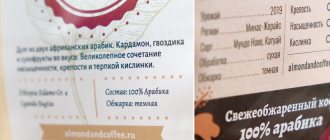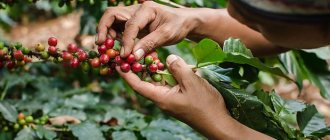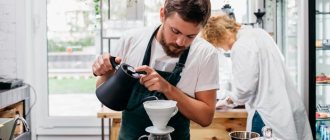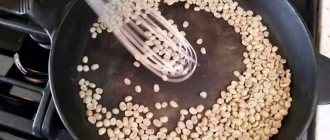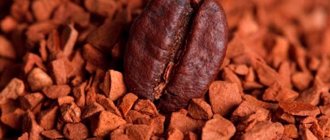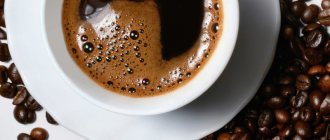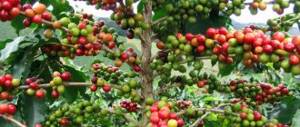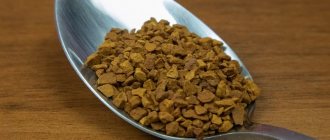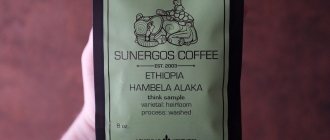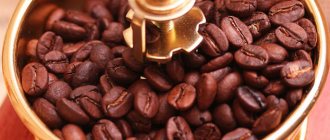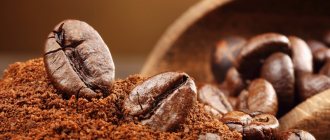Coffee is made from ground beans, but they are roasted before grinding, otherwise the drink will not work. This is both a complex and simple process, since you need to know the theory and monitor the temperature. There is a misconception that the bitterness of coffee comes solely from caffeine. In fact, caffeine is “responsible” for only 10–15% of the bitterness, the rest depends on the degree of roasting of the beans. You can even roast coffee at home, but the barista must follow certain technologies so as not to spoil the taste of the product and preserve its beneficial properties.
Story
The first evidence of coffee roasting came to us from the Ottoman Empire and dates back to the 15th century, when thin round sheets of metal or porcelain were used as utensils. They were equipped with a long handle so that it was convenient to hold the “frying pan” over a brazier with coals, periodically shaking and stirring the grains.
Around 1650, a cylindrical roaster was invented in Cairo that could roast large batches of coffee. Soon the innovation was adopted in France, Holland, Italy and other European countries.
Cylindrical roasters for roasting coffee beans
In the 19th century, many commercial roasters were patented for mass roasting of coffee. At the same time, lovers of the invigorating drink continued to roast the grains by hand on baking sheets and stoves. For such enthusiasts, a home spherical roaster appeared in Ohio in 1849. However, by the 1900s, it became much more profitable to buy pre-roasted coffee: thanks to developing technologies, it cost only slightly more than raw coffee.
Related article: how to choose a roaster for your home.
In 1903 and 1906, electric roasters were patented in the USA and Germany, respectively, the problem of smoke affecting the taste of the product was solved. In 1976, they learned to fry grains with hot air without the risk of burning them into embers. Nowadays, there are many devices for roasting coffee, ranging from banal metal meshes that must be placed over an open fire, to high-tech “smart” devices.
The boom of coffee shops in the 1970s made home roasting of coffee beans almost meaningless, turning it into the lot of fine connoisseurs - commercial roasters installed in coffee shops allow you to quickly and efficiently roast beans to any degree, you can program the roasting style, while the barista does not must stay vigilantly at the stove and stir the coffee so that the beans do not burn.
Other methods
Hairdryer
Let's find out how to properly roast coffee at home with a hairdryer. The method is optimal for the Robusta variety.
Place a colander on the bottom of an enamel pot or frying pan. Pour coffee beans into it.
Turn on a hair dryer at an average power of 1000-1200 W and heat the grains for 4-5 minutes. Stir them constantly with a spatula.
Then turn on the device at maximum power and continue processing the berries for another 4-5 minutes. Stir vigorously. The husks will fall off and they will become dark in color.
Treatment with a hairdryer lasts no more than 10 minutes.
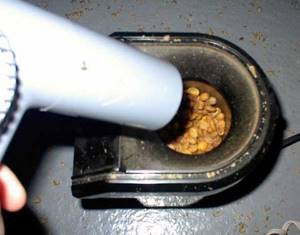
Oven
You can roast coffee berries in the oven. Preheat it to 180 degrees.
Place the grains in one row on a clean, dry baking sheet. Choose a device with holes at the bottom. They will ensure uniform heat exchange.
Roast green coffee in the oven for 5 minutes. Then reduce the temperature to 160 degrees.
After 4-6 minutes, turn off the oven and let the fried berries cool.
Interesting! Is it possible to grind coffee in a blender?
Remove the baking sheet every 2 minutes to stir the grains.
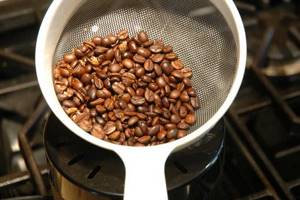
Bread maker
A bread machine is suitable for processing coffee beans at home.
Preheat the device to 200 degrees and add 200-300 grams of washed, peeled grains.
The process will take 8-9 minutes. Turn off the device after the second crack.
Roaster
You can roast your own coffee beans in a roaster. The device will ensure fast and even cooking.
Three versions of the device are available:
- convection – grains are heated by hot air;
- drum - based on a rotating drum;
- mixed.
You don’t have to spend a lot of time figuring out how to roast coffee beans. The instructions are written in clear language.
The device maintains the set temperature. There is also automatic stirring.
The downside of the device is the price, which starts at 6 thousand rubles.
Read details about the models and operating principles in the article “Review of coffee roasters.”
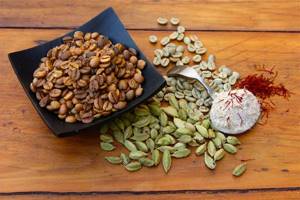
Coffee bean roasting technology
Raw coffee beans are green in color. In principle, you can eat them this way - for example, add them to a salad or infuse them with strong alcohol, but they won’t make coffee as a drink.
The industrial roasting process is divided into the following stages: sorting, roasting, cooling, packaging.
When roasting, coffee beans change color first to yellowish, then to brown, double in size (but lose weight due to evaporated water), and acquire a characteristic aroma. If everything is done correctly, tannins will decompose in the beans, the fruits will no longer be so tart and astringent, B vitamins will be retained in them, caffeine will be formed (this substance is responsible for the taste and aroma characteristics of coffee), and essential oils will be released.
Roasting temperature varies from 200 to 250 degrees Celsius. The grains must be roasted evenly, so they must be stirred constantly. A heat that is too low will not allow the flavor to fully develop, while a heat that is too high will burn the outer layer of the grain, leaving the core raw.
In industrial conditions, finished roasted coffee is cooled with air, or less often with water. Cooling is necessary because if you leave the beans to cool naturally, they will continue to roast “from the inside” due to the temperature already reached.

Industrial roaster
At approximately 196°C the beans begin to crackle, this sound (“first pop”) marks the beginning of the light roasting phase. At 224°C, a “second pop” occurs, meaning that the previously expanding grains began, on the contrary, to dry out.
In some countries, a bit of local flavor is added to the classic process. For example, in Vietnam, raw coffee beans are brushed with butter and sprinkled with sugar, so that by the end of roasting they are caramelized.
After the First Pop, the grains acquire a roasted aroma. After the Second Cotton, essential oils begin to be released.
How and why coffee is roasted
Those who are already familiar with raw coffee will agree that in terms of smell, density, color, and taste, green coffee beans are very similar to ordinary peas. Hard, wet “pebbles” are extremely difficult to grind. Coffee grinders, meat grinders, blenders break, and only with patience can you grind them using muscle power and a hammer. This process is not easy or pleasant. Therefore, suppliers quickly switched to the ground version of supplying unroasted coffee.
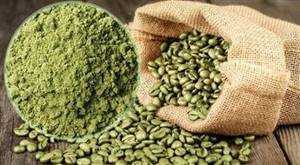
Interesting: if you try to brew coffee from unroasted, but still ground coffee, the drink will turn out a little astringent, sour in taste and, surprisingly, brown in color! Some people even like this kind of non-standard coffee, but, to be honest, there are not many of them.
The purpose of roasting is to reveal the benefits and taste of coffee beans. During its process, a huge number of chemical transformations occur inside the grain. At first glance, the roasting technology is not complicated, but it requires constant attention and skill of the roaster.
There is such a profession - roasting coffee
The special equipment used for roasting is called a roaster. Inside the unit, when exposed to heat, pale green raw coffee beans acquire a brown color and new properties.
Coffee roasters are called roasters. The quality of the product batch depends on their professionalism, experience, ability to manage the process inside the roaster, even their mood, i.e. the taste of the future drink. Properly processed coffee will demonstrate all the advantages of the variety, and the negative characteristics will be veiled by the competent actions of the master.
For your information. Every year in Russia competitions are held for the best roast master “Roaster of the Year”. The competition usually has two nominations: “Best Roaster” and “Best”. World championships among industry professionals are also held.
Where is coffee roasted on an industrial scale?
As we have already found out, coffee is roasted in roasters. You can load 12 - 15, and in some models up to 60 kg of grains at the same time. Frying temperature 200 – 250°C. There are three types of slot machines:
- drum - the most common in production;
- convection - frying occurs in them using hot air;
- mixed type - expensive, difficult to manage structures.
Addition. There are also roasters that roast coffee in small volumes from 50 to 300 g. Such units are of the drum or mixed type. They are needed to assess the proposed purchase of a large batch of raw materials. The roaster determines the flavor potential of the beans, and based on the assessment, the purchase decision is made.
After sorting the coffee beans, roasting them in a router and cooling, the finished product is packaged and sent to the consumer.

Coffee roast levels
Weak (~ up to 205 °C). Dry grains are light brown in color with a sour taste without roasted notes; the individual characteristics of the variety are perfectly felt. Caffeine content 1.37%.
Medium (~ up to 219 °C). Dark brown grains, dry, sweet and sour taste, rich aroma. The drink is full-bodied, the acidity is muted. Caffeine content 1.31%.
Strong (~ up to 230 °C). Dark brown grains, with an oily film, almost no sourness, with a bitter-sweet taste, rich roasted aroma. The individual characteristics of the variety are almost not preserved. Caffeine content 1.31%.
Maximum (highest) (~ up to 245 °C). The color of the grains is black-brown, the taste is bitter, with a “smoke”.
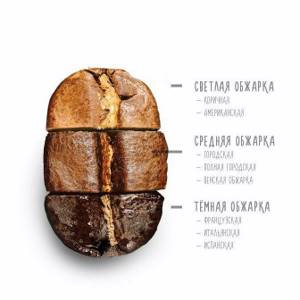
Also, degrees of roasting are divided into “light” and “dark” (based on the color of the grain).
Degrees of roasting of coffee beans
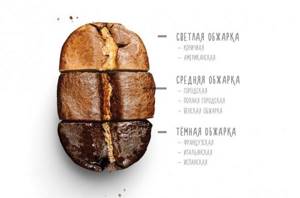
There is no unified system for classifying degrees of roasting. Each country may use its own gradations and names for them. You may come across numbering: from 1 to 5. Or names: Cinnamon roast, Viennese, Italian...

The numbers indicate coffee from the lightest roast to the darkest, when the beans acquire a dark brown, tending to black, shade of color. And usually there are five such gradations. Here, it seems, everything is clear. Let's try to correlate them with their names.
Cinnamon roast
Cinnamon (very light, light or even pale) roasting is a process where coffee beans are roasted “to the first click”. The grains become light brown and have a “dry”, that is, matte surface.
This coffee has high acidity and a refined taste. It produces tart, “herbaceous” flavors in the cup and is virtually devoid of sweetness. This roast is also known as the “New England” roast. Usually inexpensive coffee is roasted to this degree, intended for later preparation in a Turkish coffee pot and brewing in a cup.
American roast
American (light) roast coffee is beans roasted to a light brown color, but the color is not yet uniform, the coffee beans remain “variegated.” The surface of the grains is “dry”. Roasting is stopped at the “first click”.
The acidity of such grains is lower, the sweetness is more pronounced and is especially noticeable in the aroma. This roasting can highlight the characteristic features of some varieties. Light roast coffee is suitable for preparation in a Turk, French press or drip method. Many inexpensive “everyday” brands of coffee are roasted this way.
City roast
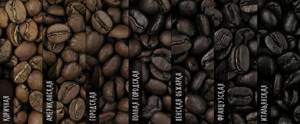
City roasting (or medium roasting) is a process in which coffee beans become brown in color, and their surface becomes slightly “oily” and acquires a barely noticeable gloss. Coffee acquires the same familiar “coffee aroma”, while it is possible to preserve the natural taste of coffee beans.
This coffee can be prepared in traditional ways: in a Turk or French press, or can be used to make espresso in a coffee machine. The taste of the drink becomes noticeable sweetness with a “caramel” hint of burnt sugar.
Full City Roast
The beans are roasted until the “second click” begins (dark roast), their color tends towards dark brown, the surface becomes more glossy. The sweetness begins to decrease and chocolate notes appear in the aroma. The taste itself becomes more intense, but already distinctly “roasted” with a slight coffee bitterness.
Coffee of this roast is used to prepare espresso in coffee machines.
Viennese roast
During Vienna roasting, coffee beans acquire a dark brown color, their surface becomes increasingly “oily” and glossy. During this roasting process, the coffee beans begin to smoke a little.
There is practically no acidity in this coffee, although the sweetness is still noticeable. Espresso is prepared from Viennese roasted coffee; the drink has a bright, rich aroma, but there are practically no natural shades left in the taste. The taste begins to fill with a characteristic “coffee bitterness”.
French roast
It is often called “The Heart of the Dark Roast.” This is probably the most popular type of roast for espresso. The beans become shiny, the coffee itself is a rich dark brown color. The grains are fried until the end of the “second click”. The taste of the drink is rich and thick, but it is already the taste of well-roasted grain. There is no longer that sophistication that is inherent in light roasted coffee beans.
Italian roast
Beans roasted to the Italian roast level become almost black and brittle. There is nothing left of the natural taste of coffee here. The taste is bitter, the aroma of coffee exudes quite strong. This type of roasting often disguises low-quality coffee beans.
Spanish roast
This roast is also known as “Neapolitan” or “Dark French roast”. The color of coffee beans can already be called black, their surface is glossy, “greasy”. The aroma of this coffee is more reminiscent of charcoal. The taste, however, is about the same. This kind of coffee is very much for everyone.
That's probably all that concerns the degrees of roasting of coffee beans. This information will help you navigate choosing coffee beans to suit your taste when you decide to buy coffee online or in a regular store. The flavors are described rather conventionally, but you can certainly understand the general direction of their development depending on the degree of roasting. However, one more important question remains.
Types of coffee roasting
It is important to remember that the final taste and aroma properties of coffee are influenced by other factors besides roasting: the type and age of the beans, the region of their cultivation, storage method, etc.
During the roasting process, the chlorogenic acid contained in coffee decomposes into quinic and caffeic acid, and bitter chlorogenic acid lactones are simultaneously formed. During intense roasting, lactones decompose, resulting in the quintessence of bitterness - phenylindanes. Therefore, the more the coffee is roasted, the more intense the bitterness.
| Roasting degree | Temperature | Appearance of grains | Taste and aroma |
| Cinnamon Roast | +195 °C | Dry, light brown | Delicate, with the aroma of freshly baked bread and pronounced sourness |
| New England Roast, Light | +205 °C | Dry, slightly darker than in the previous case | There is still sourness, but without bread notes |
| American Roast | +210 °C | Dry, rich light brown color | Sourness combines with delicate bittersweet notes |
| City Roast | +220 °C | Dry, rich brown color | Bittersweet notes are felt more clearly, the sourness weakens. This roast is good for coffee tastings |
| Full City Roast | +225 °C | Rich brown color, with the first drops of oil on the surface | Shades of chocolate and caramel appear in the taste |
| Vienna Roast | +230 °C | Surface oily, color dark brown | The sourness disappears, the caramel tones become more intense |
| French Roast | +240 °C | Color – dark brown, more oil on the surface | Burnt tones are woven into caramel shades, and astringency appears. This roast is considered optimal for making espresso. |
| Italian Roast | +245 °C | The color is getting darker, there is more oil | The bitterness is felt more and more clearly. Roast suitable for espresso |
| Spanish Roast | +250 °C | Brown-black color, oily surface | Sharp bitter taste with notes of burnt coffee. Not all varieties can withstand this degree of roasting: some grains simply become charred. |
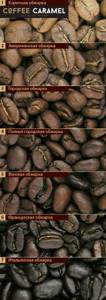
Roast markings from coffee producers
Each coffee manufacturer has its own roasting scale. Some simply indicate intensity with numbers from 1 to 5:
- 1 – Cinnamon (Light);
- 2 – American or Urban (Medium);
- 3 – Full city or Viennese (Medium-dark);
- 4 – Italian (Dark);
- 5 – French or Spanish (Very dark).
Other manufacturers distinguish 3 degrees:
- weak (usually corresponds to American or Urban);
- middle (Viennese);
- strong (French or Italian).
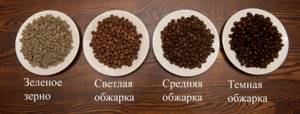
Light roast coffee
Appearance:
light brown color, no oil on the surface of the grains
Taste: pronounced sourness
Smell:
rich coffee
Temperature:
180-205°C
When the internal temperature of the beans reaches 205°C, the beans crack and increase in size. This process is known as “first crack”. Light roasting involves processing the beans until the first crack.
Contrary to popular belief, light roasts retain more caffeine than medium and dark roasts. Caffeine concentration is related to the ratio of coffee to water in the bean: the more water, the stronger the coffee, the more caffeine it contains. Light roasts evaporate the least amount of water. In addition, the beans retain the original taste and aroma characteristic of the climate and soil in which the coffee was cultivated.
Some of the most popular light roast coffee varieties are:
- Cinnamon roast is the lightest. It is obtained by slow roasting at low temperatures.
- Light (Light city) - higher temperature, fried a little longer than cinnamon.
Roasting coffee at home
At home, coffee can be roasted in a frying pan/grill, in an oven, in a popcorn machine, or in a special roaster. The first two methods are the cheapest and simplest, the latter are the most effective. In theory, even a microwave oven will do. In practice, this method has not proven itself to be the best, since the grains are roasted poorly and unevenly.
Methods:
- Frying pan or grill. Pros: fast, convenient, cheap. Cons: It is difficult to maintain an accurate temperature if roasting over an open fire - the smoke affects the taste of the grain.
- Oven. Pros: cheap. Cons: slow, difficult to achieve uniform roasting of coffee beans.
- Popcorn machine. Pros: simple, the beans are mixed automatically, it’s easy to achieve uniform roasting. Cons: not intended for roasting coffee (if it breaks, the warranty will not be valid), high price.
- Roaster. Pros: designed for roasting coffee, easy to use. Cons: expensive.
After the first pop, beans for weak light coffee are obtained. After the second – medium-roasted grains. If you want a deep roast, wait 30 seconds after the second pop.
Immediately after roasting, you need to cool the beans - this can be done by pouring the coffee into a colander and directing a stream of cold air at it.
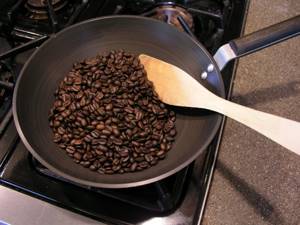
The pan must be completely dry and clean
When coffee is roasted, carbon dioxide is released, a process that continues even after the beans have been removed from the heat. Therefore, freshly roasted beans should be allowed to sit for about 12 hours, and only then poured into a container or sent for grinding.
If too much gas accumulates in the coffee, the lid of the container may be knocked off, and the gas will negatively affect the taste of the drink. To fully “mature”, gain taste, body and aroma, the grains need about 24 hours. On the other hand, you shouldn’t forget about roasted grains for longer than a week either - the taste will become musty and stale.
